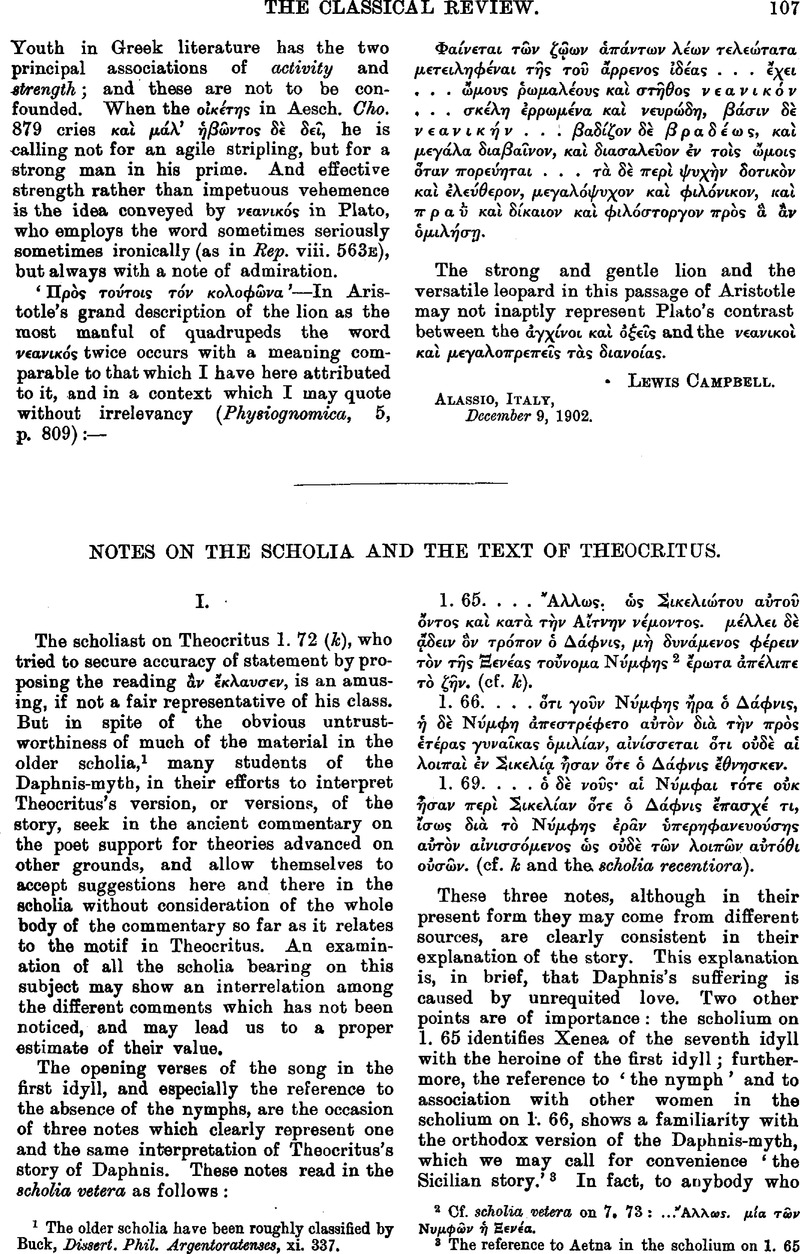No CrossRef data available.
Article contents
Notes on the Scholia and the Text of Theocritus
Published online by Cambridge University Press: 27 October 2009
Abstract

- Type
- Original Contributions
- Information
- Copyright
- Copyright © The Classical Association 1903
References
page 107 note 1 The older scholia have been roughly classified by Buck, , Dissert. Phil. Argentorotenses, xi. 337Google Scholar.
page 107 note 2 Cf. scholia vetera on 7. 7 3 : ![]() .
.
page 107 note 3 The reference to Aetna in the scholium on 1. 65 is, of course, taken from the text of Theocritus rather than from Timaeus. A summary of the ancient evidence for the Sicilian story may be found in Harvard Studies in Classical Philology, x. 124, 125Google Scholar: the position taken in that article with regard to Theocritus's version of the story is untenable.
page 108 note 1 The necessary variations from the MS. may be seen in Ziegler's apparatus.
page 109 note 1 Although it is no part of my present purpose to consider the true meaning of Theocritus's first and seventh idylls, I may suggest my own view of the difficult problem. The interpretation offered by Reitzenstein, , Epigramm und Skolion, 213Google Scholar, seems to me correct, except in so far as it is marred by the author's belief in the mysticism of the first idyll: to omit the parts with which I do not agree— ‘Daphnis hat sich gerühmt, der Aphrodite fern zubleiben, … Darum zürnt die Göttin und sendetihm verzehrende Liebe, … Bis zum Tode leisteter dem Trieb der Göttin Widerstand, noch im Hades wird er der Feind des Eros, …’ I see no reason why so many students of the subject from Lennep (quoted in Meineke3 on 1. 85) down Helm (Philologus, lviii. 111 ff.) insist that the of Daphnis was not Requited, and so accept the commentary, in part, of the scholiasts on 1. 85, or emend ζάτεισ', as Helm does. Why need we, with Hiller on 1. 82, assume that Theocritus did not mean to ascribe to Priapus a more intimate knowledge of Daphnis's love affairs? Hermes was ignorant, for he had no interest in such matters; Priapus was just the person to know all the details. Boeder's article, ‘Die Sage vom Daphnis,’ in the Ussing-Festschrift, is not accessible to me.
page 110 note 1 As Helm, Philologus, lviii. 119.
page 110 note 2 Hiller, note on 8. 93.
page 110 note 3 Concerning Theon and his edition, see Ahrens, , Bucol. Gr. Reliq. II. xxvii.–xxxLGoogle Scholar, Philologies, xxxiii. 392Google Scholar, and Bethe, , De Theocriti editionibus, 9 ffGoogle Scholar.
page 111 note 1 The different spellings of the proper name Hermesianax, which I take from Ziegler, and of the genitive of Μενλκας, in these two comments, are worth noticing. The mistake in the former might be significant if we could be sure that the editor was not at fault.
page 111 note 2 Rohde points out that there is no trace of a pederastic motif elsewhere in Hermesianax.
page 111 note 3 See the apparatus of Ahrens and of Ziegler. Recent editors, with the exception of Cholmeley, assume a lacuna after 52, and give 53–56 to Menalcas: in this case τν, of course, refers to Milo.
page 111 note 4 The older editions of Euripides read φπτεται with the MSS. In Bacchae 778, but the verb is now corrected to ύφπτεται, the reading in the Christus Pattern.


